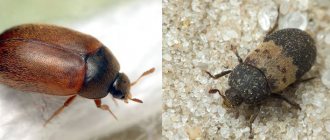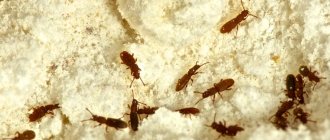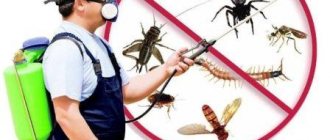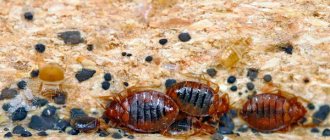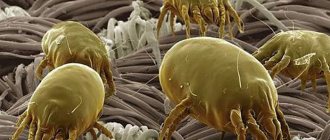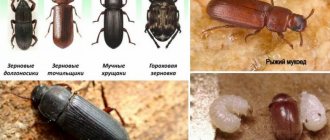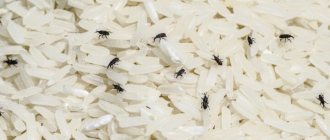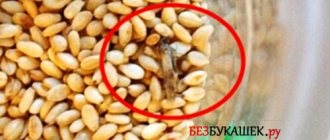10.07.2019
Sometimes even the cleanest owner of an apartment or house can have small black bugs in her cereals and flour. If measures are not taken to get rid of pests in a timely manner, they can become a serious problem. Let's look at how to permanently destroy uninvited guests.
- What types of bugs are found?
- Causes of insects in the kitchen
- Where do pests most often occur?
- How dangerous are cereals with bugs?
- 7 most effective pest control products
- Note to housewives
What types of bugs are found?
Tiny pests can live in the kitchen:
- Surinamese mucoeds.
Suriname mucoed
These exotically named beetles love cereals and thrive in them. Females of these insects often breed in warehouses. Tiny eggs cannot be seen by humans with the naked eye. Adult beetles and larvae can enter living spaces in bags of bulk foods such as cereals, pasta and rice. However, the Surinamese flour eater (its maximum length is 2 millimeters) loves not only cereals. It can spoil nuts, crackers, concentrates, dried fruits, dried fruits, and cookies.
- Flour beetle. This is the name given to a small beetle with a maximum body length of 4 millimeters. These insects in the kitchen settle in bags containing cereals, kitchen containers for bread, and cabinets.
flour beetle
They have an orange color, which is clearly visible on light-colored surfaces. They feed on flour from wheat and rye, as well as semolina, rice and other cereals.
- Grinder. These parasites, often found in the kitchen, have oval-shaped heads. The maximum length is 3 millimeters. These insects in cereals have a color ranging from dark yellow to brown. They easily gnaw their way through floors, doors, and window sills. Found in flour, cereals, they also love nuts, dried fruits, and cookies. In addition, they often eat wood, sweets, and pasta.
Grinder
- Food moth. This pest also often lives in flour. It does not belong to beetles, but to Lepidoptera, essentially being a tiny butterfly.
food moth
Where does flour beetle come from in an apartment?
The main way for a beetle to enter an apartment is to purchase products that have already been contaminated. Surely you have had a situation where, after buying groceries, you open the package, and there are larvae or bugs swarming around there. Infection occurs in warehouses and storage facilities when storage rules are not followed.
The large beetlefish feels good in the attic with pigeons, lives and reproduces, as it can feed on animal substances, such as the remains of feathers. Once in a multi-storey building with the help of birds, where the beetle cannot find a suitable place for breeding and food, it enters the apartments through the ventilation shafts.
Causes of insects in the kitchen
Why do such pests appear in cereals? They strive to live in places where there is a sufficient amount of food, in particular, access to bread products and cereals is provided.
Bags that do not close tightly enough and contain flour and cereals, rice or semolina, after being scattered on the shelves, become attractive to mealworms, grinders, and flour eaters.
A large amount of pasta and cereals also attracts food moths. Parasites often spoil products such as cookies, crackers, dried fruits, nuts, concentrates and bread. House grinders settle in places where there is a large amount of dried wood, and there are food supplies nearby. For this reason, harmful insects often live in kitchens.
Intensive reproduction of parasites in cereals leads to their colonization, in addition to the kitchen, also in other rooms of the apartment or private house - a pantry, a room in which homeowners can sometimes eat while watching TV. Bugs are sometimes found, in addition to bags of cereals and bread bins, also in textiles and furniture.
If you are concerned about the question of how to remove such insects, first of all you should realize that if you have food in the kitchen, they can always appear, even if you maintain perfect order.
Possible sources of infection:
- The most common source of harmful bugs in kitchens is the grocery store. After all, even inside a sealed bag of cereal, these pests can be found. They often find their way into cereals and other grocery products. This happens both during sorting and in the store itself if storage conditions are violated.
- Neighbours. Infection from them is possible through the ventilation system. If your neighbors do not pay attention to this problem, over time, groups of bugs will get closer to you through the ventilation system. Since their reproduction occurs quite intensively, they quickly become noticeable.
- Sometimes beetles settle in textiles and wooden objects. Therefore, it is recommended to thoroughly wash towels and oven mitts, and place wooden utensils in the freezer for 2 hours.
If you notice even one bug, this is a reason for treatment and preventive measures. For this reason, you should carefully monitor the condition in which your kitchen is located when processing cereals after purchasing them. Also, many bugs like pet food, so you should put it away in the refrigerator or pantry.
In general, these insects, of course, do not appear out of nowhere; they almost never come into the home themselves. There may be several reasons:
- Delivery of parasites by the owners themselves with food. With all modern standards and GOSTs in trade and production, the acquisition of a product infected with parasites is by no means uncommon.
- Getting into the cereal even at the stage of its production, for example, at a factory where the cereal is neutralized from parasites, dried, and packaged.
- Getting into a bag during transportation or in a warehouse.
- Often such bugs live in stores. There they quickly populate every fresh batch of groceries.
- They also live in bakeries and bread factories. From there they enter homes in loaves and bundles of dry bread.
- Bugs can also enter with food products from neighbors who shared flour, friends or relatives who sprinkled a little nuts or dried fruits.
- Since these pests are unpretentious, they are able to penetrate furniture cracks. For this reason, one of the reliable methods for bringing such insects into your home is to buy used kitchen furniture or interior parts in which they live and quickly crawl out of them into a new home, settling near food.
Habitats of the flour beetle
Small Khrushchak prefers to live in warehouses, granaries, pasta factories, but is also found in apartments. Females penetrate into the smallest cracks in boxes, bags or bags of food and even into cracks in walls, breeding under wallpaper. Plastic, paper or fabric are chewed by harmful insects. Due to the fact that the eggs are covered with sticky mucus, they stick firmly to any surface.
For housing, they choose pantries, kitchen drawers (scattered cereal), and places where there is a lot of dust, such as baseboards. This does not mean that pests sit quietly in the products and do not crawl out anywhere; if their numbers are large, they feel like full-fledged masters in the apartment and crawl anywhere, only smooth vertical surfaces are beyond their power. For tormentors, damp, stale foods are preferred, and if there are such places in the house, perhaps you store pasta or cereal on the balcony, in a closet where there is no ventilation, most likely the place where bugs spread is located there.
The large beetle needs high humidity to develop, while the small one lives happily in dry apartments with heating.
Where do pests most often occur?
If the kitchen is already infected and there are these insects in flour or cereal, you need to detect foci of infection. You will need to review each of the products.
Bulk products
The following subtleties need to be taken into account:
- It is important that you will need to examine any product, without exception, that is stored in the kitchen. Each type of such bugs has certain gastronomic tastes. But if his favorite food is not available in sufficient quantities, the bug can emigrate from other grains to cereals, as well as sugar, sweets, and nuts. For this reason, you should not skip a single product, so as not to waste a lot of time.
- These parasites become strongly attached to their places of residence, so they do not go far from them. If you see them on the shelf, you must first inspect the products stored nearby.
- Even if the package is hermetically sealed, it will need to be inspected. These insects easily chew through materials such as cardboard, cellophane and foil. For this reason, without opening the cereal, you should not think that it does not contain parasites.
- The best option is to pour the cereal into a plate and watch carefully. These bugs also live hidden - for example, the grinder can gnaw holes in grains and live in them, crawling to the surface only to change the grain. Therefore, a superficial inspection is ineffective.
How to fight and get rid of insects using chemical means
You can get rid of insects in an apartment not only with folk remedies. But chemicals cannot be used to clean cereals, as they pose a danger to humans. Once in the body with food, the toxin can cause acute poisoning, at a minimum.
Insecticides in the form of emulsions and aerosols are sprayed in rooms from which all products have already been removed. The procedure is usually carried out as one of the points in a comprehensive pest persecution plan. After treatment, it is forbidden to stay in the room for some time if it is not ventilated, but food cannot be stored for even longer.
The only substance of this type that is relatively safe for humans is Pyrethrum. The natural insecticide is based on Dalmatian chamomile and is often used to treat indoor plants.
Important: the use of chemicals is carried out exclusively in accordance with the instructions on the packaging.
How dangerous are cereals with bugs?
Eating contaminated cereals or flour containing bugs is unacceptable. However, after the products are processed, this is quite possible, but of course it is hardly pleasant. It is important to understand here that while sorting or sifting cereals, it is still impossible to completely get rid of the larvae, as well as traces of the vital activity of these pests.
In small quantities, this does not pose a threat to healthy adults. However, for children and weakened people there is a risk of intoxication, accompanied by stomach upset, vomiting and fever.
In the absence of medical problems and ignoring the psychological factor, it is possible to consume contaminated products if they are first processed - heating or freezing.
Bugs in the cereal
Almost all of these insects with larvae die in temperatures below -15 and above +50. How to achieve this:
- To freeze a bag of cereal, you need to put it in the freezer for a day. In winter, you can take food outside or onto the balcony, but you need to take into account that the temperature should not exceed -15.
- To heat, you need to pour the cereal onto a baking sheet, spread it over the surface, and put it in the oven for 30 minutes, heated to +200.
- After freezing or heating, flour can be sifted through a fine sieve, which will retain the insects themselves, larvae, and eggs. Once these steps are complete, the flour can be safely used.
Is it possible to eat grains and flour infested with beetles?
Food should not be consumed together with insects. Before using cereals, you need to get rid of pests.
However, even careful processing will not be able to remove larvae, scales, and waste products of beetles. They pose no danger to a healthy adult.
Before using cereals you need to get rid of pests
It’s a different matter when it comes to children and people with weakened immune systems. In these cases, the use of such products can cause a severe allergic reaction or cause intoxication of the human body, which will lead to disruption of the functioning of the gastrointestinal tract and an increase in body temperature.
Note to housewives
To avoid having to fight parasites, it is advisable to insure yourself against their occurrence in advance. In order not to rack your brains over how to remove them, you need to maintain cleanliness, ensuring periodic ventilation of the cabinets. If the furniture products are highly airtight, then the air circulation in them does not matter; you should constantly ventilate the furniture by opening the cabinets for a short time. Other preventive measures:
- Avoid storing groceries in large quantities. This will not save you from bugs in flour and cereals, but it will significantly reduce the damage if parasites do settle in.
- Use airtight containers, glass and plastic, and tight lids.
- If there are large reserves, dust should be used. It is available in markets and stores. This substance crumbles onto the floor and under bags. Dust repels insects, but is completely safe for people.
- Different products should be kept separately, not storing everything on a single shelf. For example, it is better to hide dried fruits away from cereals.
- Garlic is an effective preventative. You should put one slice of it in each jar of cereal. You can place dry bay leaves between the jars; parasites do not like its smell.
Garlic with laurel
- If cereals are stored in textile bags, you can “salt” these products. For this purpose, prepare a salt solution (2 tablespoons per 1 liter), then soak the bags in it. After 30 minutes, these bags should be taken out and dried. After this treatment, pests do not approach the bags.
Tips and tricks
- The main advice is, of course, cleanliness combined with a few little tricks.
- When buying cereal or flour, do not rush to immediately pour it into a jar and put it in the cupboard. It is better to put the bag in the freezer overnight, or even for a day. If the cereal is infected, then this, of course, will not get rid of the bugs. But at low temperatures they will die, like their larvae and eggs, which means they will not reproduce and move to your other reserves.
- Make it a rule when cleaning cabinets to wipe them with a vinegar or water-salt solution. Dilute 9% vinegar with water 1:1 or add a spoonful of regular baking soda and salt to 1 liter of water.
- Nutmeg is a very aromatic remedy. Grind the nut as much as possible on a grater or in a mortar and, to prevent it from scattering all over the surface, take a wide piece of tape and evenly spread the resulting nut powder in a thin layer onto its strips. Then shake off the excess from the strips and cut into the amount you need. Place these nutmeg strips of scotch tape in the boxes. An effective and pleasant means of preventing bugs. You can also sprinkle already ground nutmeg from bags onto the tape.
- Lavender is another fragrant and simple remedy. Simply place the dried herbs on the shelves.
